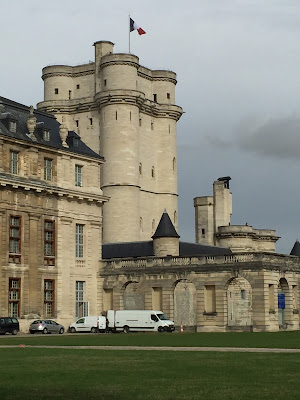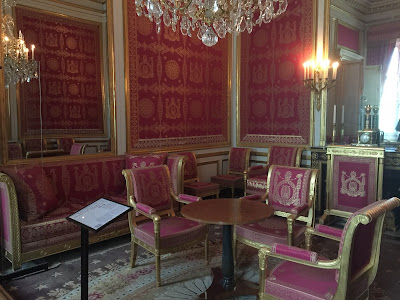The French word "château" denotes buildings as diverse as a medieval fortress,
a Renaissance palace and a 19th-century country house, dependent upon the
nature of the building in question. Most French châteaux are "palaces" or "country houses" and
not "castles", and for these the English word "château" is
appropriate. Sometimes the word "palace" is more appropriate. To give
an outstanding example, the Château de
Versailles is so called because it was located in the countryside (rural)
when it was built, but it does not bear any resemblance to a castle, so it is
usually known in English as the Palace of Versailles. In French where
clarification is needed, the term château
fort is used to describe a castle, such as Château fort de Roquetaillade.
The urban counterpart of château is palais, which in French is applied only to grand houses in a city.
This usage is again different from that of the term "palace" in
English, where there is no requirement that a palace must be in a city, but the
word is rarely used for buildings other than the grandest royal residences. The
expression hôtel particulier is used
for an urban "private house" of a grand sort. In the city of Paris, the Louvre (fortified) and the Luxembourg
(originally suburban) represented the original château but lost their château
etymology, becoming “palaces” when the City enclosed (around) them.
(Château de Vincennes - front view of the keep/donjon circa 1337)
Château de Vincennes: The Château de Vincennes is a massive 14th
and 17th century French royal fortress in the town of Vincennes, to the east of Paris,
now a suburb of the metropolis.It had its origins as a hunting lodge, constructed for Louis VII about 1150 in the forest of Vincennes. In the 13th century, Philip Augustus and Louis IX erected a more substantial manor: Louis IX is reputed to have departed from Vincennes on the crusade from which he did not return. Vincennes was more than a grim fortress: Philippe III (in 1274) and Philippe IV (in 1284) were each married there and three 14th-century kings died at Vincennes: Louis X (1316), Philippe V (1322) and Charles IV (1328).
To strengthen the site, the castle was greatly enlarged replacing the earlier site in the later 14th century. A donjon tower, 171 feet high, the tallest medieval fortified structure of Europe, was added by Philip VI of France, a work that was started about 1337. The grand rectangular circuit of walls, was completed by the Valois about two generations later (ca. 1410). The donjon served as a residence for the royal family, and its buildings are known to have once held the library and personal study of Charles V. Henry V of England died in the donjon in 1422 following the siege of Meaux.
(the cell of the marquis de Sade)
On 20 August 1944, during the battle for the
liberation of Paris, 26 policemen and
members of the Resistance arrested by soldiers of the Waffen-SS were executed
in the eastern moat of the fortress, and their bodies thrown in a common grave.
(entrance to the château - the château is surrounded by a moat)
Only traces remain of the earlier castle and the substantial remains date from the 14th century. The castle forms a rectangle whose perimeter is more than a kilometer in length (1,083 x 574 ft). It has six towers and three gates, each originally 43 feet high, and is surrounded by a deep stone lined moat. The keep, 171 feet high, and its enceinte occupy the western side of the fortress and are separated from the rest of the castle by the moat. The keep is one of the first known examples of rebar usage.
(Château de Fontainebleau - front entrace)
Château de Fontainebleau: The Château de Fontainebleau, located 34
miles southeast of the center of Paris,
in the commune of Fontainebleau, is
one of the largest French royal châteaux.
The medieval castle and subsequent palace served as a residence for the French
monarchs from Louis VII (1120-1180)
to Napoleon III (1808-1873). The
earliest record of a fortified castle at Fontainebleau
dates to 1137. It became a favorite residence and hunting lodge of the Kings of
France because of the abundant game and many springs in the surrounding forest.
(medieval keep - circa 1137)
Following the death of Henry II (1519-1559), his widow, Catherine de' Medici, continued the construction and decoration of the château. Including the section known today as the wing of the Belle Cheminée, noted for its elaborate chimneys and its two opposing stairways. In 1565, as a security measure due to the Wars of Religion, she also had moat dug around the château to protect it against attack.
(King Henry IV)
King Louis
XIV (1638-1715) spent more days at Fontainebleau
than any other monarch; he liked to hunt there every year at the end of summer
and the beginning of autumn. Louis XIV
signed the Edict of Fontainebleau at
the château on 22 October 1685,
revoking the policy of tolerance towards Protestants begun by Henry IV.
On May 19–20, 1717, during the Regency
following the death of Louis XIV, the
Russian Czar Peter the Great was a guest at Fontainebleau.
A hunt for stags was organized for him, and a banquet.
King Louis
XVI (1754-1793) also made additions to the château to create more space for his courtiers. Louis XVI and Marie-Antoinette made their last visit to Fontainebleau in 1786, on the eve of the French Revolution.
(Queen's bedroom - decorated by Marie-Antoinette)
During the French Revolution the Château did not suffer any significant damage. Napoleon chose Fontainebleau as the site of his historic 1804 meeting with Pope Pius VII, who had travelled from Rome to crown Napoleon Emperor. Napoleon's visits to Fontainebleau were not frequent, because he was occupied so much of the time with military campaigns. Between 1812 and 1814, the château served as a very elegant prison for Pope Pius VII.
(Pope's bedroom - part of the 'apartment' where he was held captive)
Napoleon
spent
the last days of his reign at Fontainebleau,
before abdicating there on 4 April 1814. On 20 April, after failing in an
attempt to commit suicide, he gave an emotional farewell to the soldiers of the
Old Guard, assembled in the Court of Honor. In his memoires, written while in
exile on Saint Helena, he recalled his time at Fontainebleau; “…the true residence of Kings, the house of the
centuries. Perhaps it was not a rigorously architectural palace, but it was
certainly a place of residence well thought out and perfectly suitable. It was
certainly the most comfortable and happily situated palace in Europe.”
(Table used by Napoleon Bonaparte to sign his abdication documents)
Following the restoration of the Monarchy, Kings Louis XVIII and Charles X each stayed at Fontainebleau, but neither made any major changes to the palace. Louis-Philippe was more active, both restoring some rooms and redecorating others in the style of his period.
Emperor Napoleon
III, who had been baptized at Fontainebleau,
resumed the custom of long stays at Fontainebleau,
particularly during the summer.
(note: my
personal preference is Château de
Fontainebleau over Château de
Versailles, it is far more beautiful - but the Jardins des Versaille are better)
First built by Louis XIII in 1624, as a hunting lodge of brick and stone the edifice was enlarged into a royal palace by Louis XIV. During the second phase of expansion of the mansion (c. 1678–1715), included what became the most famous room of the palace, the Hall of Mirrors.
On 6 May 1682, Versailles became officially the seat of the government of the
kingdom of France, the home of the French King Louis XIV, and the location of the royal court. By requiring that
nobles of a certain rank and position spend time each year at Versailles, Louis XIV prevented them from developing their own regional power
at the expense of his own and kept them from countering his efforts to
centralize the French government in an absolute monarchy.
Two of the three treaties of the Peace of Paris (1783), in which the
United Kingdom recognized the independence of the United States, were signed at
Versailles. The palace still serves
political functions. The palace that we recognize today was largely completed by the death of Louis XIV in 1715. Flanking the Royal Court are two enormous asymmetrical wings that result in a facade of 1,319 ft in length. Encompassing 721,182 sq ft the palace has 700 rooms, more than 2,000 windows, 1,250 fireplaces and 67 staircases.
The Gardens of Versailles is situated to the west of the palace, the gardens cover some 1,977 acres of land, much of which is landscaped in the classic French Garden style. In addition to the meticulous manicured lawns, parterres of flowers, and sculptures, are the fountains, which are located throughout the garden. Dating from the time of Louis XIV and still using much of the same network of hydraulics as was used during the Ancien Régime, the fountains contribute to making the gardens of Versailles unique.
To clarify – in general a Château is rural, fortified, and landed while a Palais is urban and not fortified.
(thank you Wikipedia)













